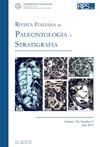DIETARY TRAITS OF LATE MIOCENE HIPPARIONS FROM MARAGHEH REVEALED THROUGH DENTAL WEAR
IF 1.9
3区 地球科学
Q2 GEOLOGY
引用次数: 0
Abstract
This study investigates the palaeoecology of fossil perissodactyls (equids) from the late Miocene of Maragheh, northwestern Iran. We used dental micro- and mesowear techniques to draw robust inferences about fossil equid paleoenvironment. Mesowear and microwear analyses were applied to the upper molars of three species of hipparionine horses. For this purpose, we investigated samples from three fossiliferous localities: Rohanion, Azim, and Cizdahaban. Six fossil specimens were analyzed for enamel meso- and microwear and results were compared to an extensive database of extant ungulates. Results indicated overlap of the Maragheh hipparions with the dietary signal of extant grazers and grass-dominated mixed feeders. This is consistent with the supposed vegetational habitat proposed by previous mesowear studies. The different species of hipparions from Maragheh had similar diets and were consuming a mixture of plants but with a preference for grasses. These results are consistent with paleoenvironmental reconstructions of the late Miocene dominated by open grassland areas among more wooded settings.马拉赫中新世晚期嬉皮士的饮食特征
本研究调查了伊朗西北部马拉赫中新世晚期马化石的古生态学。我们使用牙齿微磨损和中磨损技术对化石等古环境进行了有力的推断。对三种马齿苋的上臼齿进行了中磨损和微磨损分析。为此,我们调查了三个化石产地的样本:罗赫尼翁、阿齐姆和奇兹达哈班。对六个化石标本的釉质中磨损和微磨损进行了分析,并将结果与现存有蹄类动物的广泛数据库进行了比较。结果表明,马拉赫海雀和现存食草动物和以草为主的混合饲养者的饮食信号重叠。这与之前的中磨损研究提出的所谓植被栖息地是一致的。马拉赫的不同种类的hipparion有着相似的饮食,它们食用混合植物,但更喜欢草。这些结果与中新世晚期的古环境重建一致,中新世以树木繁茂的开阔草地为主。
本文章由计算机程序翻译,如有差异,请以英文原文为准。
求助全文
约1分钟内获得全文
求助全文
来源期刊
CiteScore
3.60
自引率
4.30%
发文量
28
审稿时长
>12 weeks
期刊介绍:
The Rivista Italiana di Paleontologia e Stratigrafia was founded in 1895. It publishes original papers dealing with all fields of paleontology and of stratigraphy, from Italy and the Mediterranean to the Tethys, as well across the globe from China to North America.

 求助内容:
求助内容: 应助结果提醒方式:
应助结果提醒方式:


